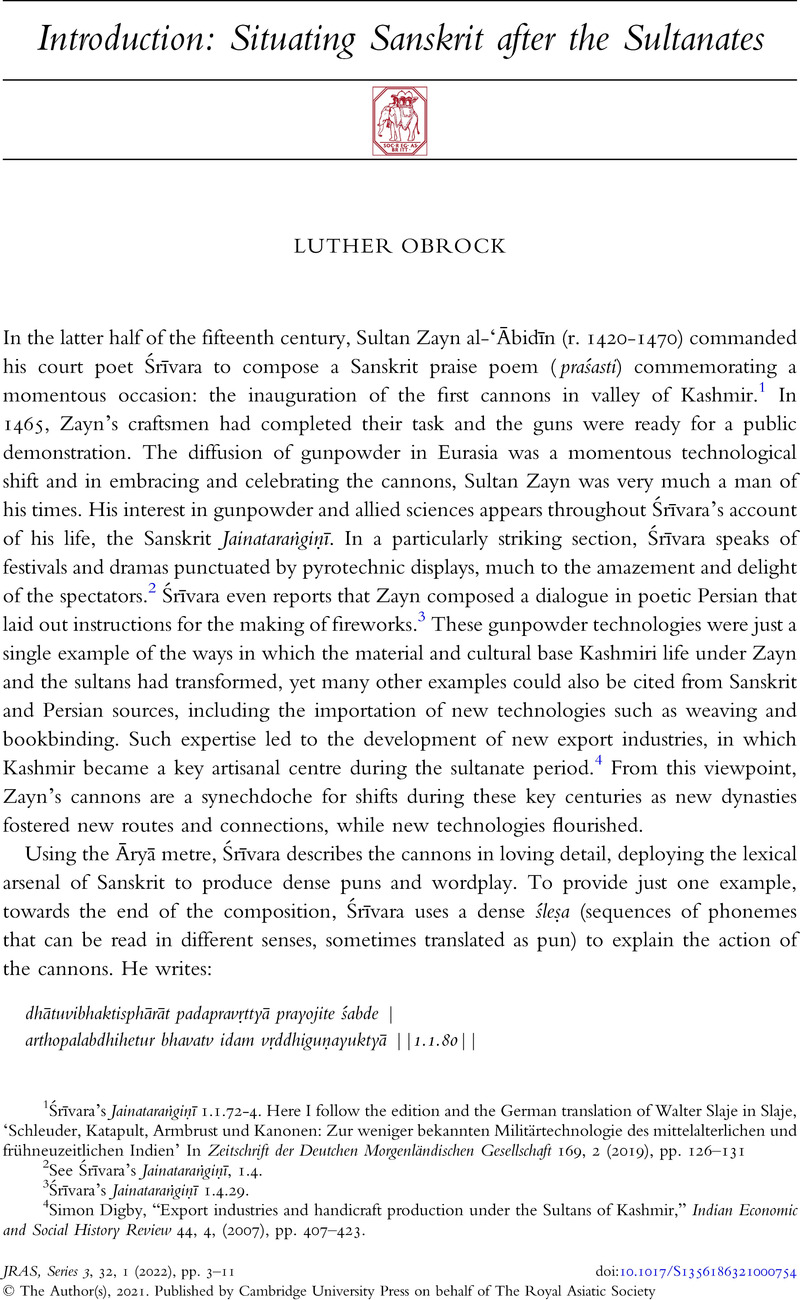No CrossRef data available.
Article contents
Introduction: Situating Sanskrit after the Sultanates
Published online by Cambridge University Press: 07 September 2021
Abstract

- Type
- Introduction
- Information
- Journal of the Royal Asiatic Society , Volume 32 , Special Issue 1: Situating Sanskrit after the Sultanates , January 2022 , pp. 3 - 11
- Copyright
- Copyright © The Author(s), 2021. Published by Cambridge University Press on behalf of The Royal Asiatic Society
References
1 Śrīvara's Jainataraṅgiṇī 1.1.72-4. Here I follow the edition and the German translation of Walter Slaje in Slaje, ‘Schleuder, Katapult, Armbrust und Kanonen: Zur weniger bekannten Militärtechnologie des mittelalterlichen und frühneuzeitlichen Indien’ In Zeitschrift der Deutchen Morgenländischen Gesellschaft 169, 2 (2019), pp. 126–131
2 See Śrīvara's Jainataraṅgiṇī, 1.4.
3 Śrīvara's Jainataraṅgiṇī 1.4.29.
4 Digby, Simon, “Export industries and handicraft production under the Sultans of Kashmir,” Indian Economic and Social History Review 44, 4, (2007), pp. 407–423CrossRefGoogle Scholar.
5 For more details on the mechanics of firing a cannon, especially how they seemed to be impelled with a kick, see Slaje, ‘Schleuder, Katapult, Armbrust und Kanonen’, pp. 130–131.
6 For a history of śleṣa in Sanskrit literature, see Yigal Bronner, Extreme Poetry: The South Asian Movement of Simultaneous Narration (New York, 2010).
7 For instance, his word for “cannonball”, vajrabāṇa translates literally as “thunderbolt-arrow” and the word for “cannon” is yantrabhāṇḍa, literally “mechanism-vessel”.
8 S. N. Dasgupta A History of Sanskrit Literature: Classical Period. Vol. 1 (Calcutta, 1962), p. cxviii.
9 Sheldon Pollock, Language of the Gods in the World of Men: Sanskrit, Culture, and Power in Premodern South Asia (Berkeley, 2006).
10 Pollock, S., ‘The Death of Sanskrit’ In Comparative Study of Society and History, 43, 2 (2001), p. 395CrossRefGoogle Scholar.
11 Pollock, ‘Death of Sanskrit,’ p. 417.
12 See for instance, Hanneder, J.. ‘On “The Death of Sanskrit,”’ Indo Iranian Journal 45. (2002), pp. 293–310CrossRefGoogle Scholar.
13 Bronner, and Shulman, , ‘A Cloud Turned Goose: Sanskrit in the Vernacular Millennium’, Indian Economic and Social History Review, 43, 1 (2006), p. 6CrossRefGoogle Scholar.
14 Bronner and Shulman, (2006), p. 5.
15 J. Knutson, Into the Twilight of Sanskrit Court Poetry: The Sena Salon of Bengal and Beyond (Berkeley, 2014).
16 R. Eaton, “The Persian Cosmopolis (900-1900) and the Sanskrit Cosmopolis (400-1400), in The Persianate World: Rethinking Shared Space, (eds.) A. Amanat and A. Ashraf (Leiden, 2018), pp. 63–83.
17 Alam, M., ‘The Pursuit of Persian: Language in Mughal Politics,’ Modern Asian Studies 32, 2 (1998), pp. 317–349CrossRefGoogle Scholar.
18 A. Truschke, A Culture of Encounters: Sanskrit at the Mughal Court (New York, 2016).





